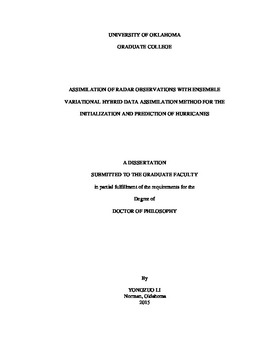| dc.description.abstract | Data assimilation is a critical component for accurate model forecast. This dissertation investigated the ensemble-variational hybrid data assimilation methods using land based radar and airborne radar data for the prediction of Hurricanes.
In the first part of this dissertation, an enhanced version of the hybrid ensemble-3DVAR data assimilation system for the WRF model is applied to the assimilation of radial velocity (Vr) data from two coastal WSR-88D radars for the prediction of Hurricane Ike (2008) before and during landfall. In this hybrid system, flow-dependent ensemble covariance is incorporated into the varitional cost function using the extended control variable method. The analysis ensemble is generated by updating each forecast ensemble member with perturbed radar observations using the hybrid scheme itself. The Vr data are assimilated every 30 minutes for 3 hours immediately after Ike entered the coverage of the two coastal radars. The hybrid system is compared with the WRF 3DVAR results after tuning to its background error covariance correlation scale.
The hybrid method produces temperature increments showing rainband structures and positive increments in the vortex core region, and a warm core throughout the hurricane depth in the final analysis. In contract, the 3DVAR produces much weaker and smoother increments with negative values at the vortex center at lower levels. The unturned WRF 3DVAR produces wind increments that are inconsistent with the hurricane vortex circulations. Forecasts from the hybrid analyses fit the observed radial velocity better than that from 3DVAR, and the 3-h accumulated precipitation forecasts are also more skillful. The track forecast is slightly improved by
the hybrid method and slightly degraded by the 3DVAR compared to the forecast from GFS analysis. All experiments assimilating the radar data show much improved intensity analyses and forecasts compared to the experiment without assimilating radar data. The forecast results indicate that the hybrid method produces dynamically more consistent state estimations that lead to lower error growth in the forecast than the 3DVAR method does, and there is little benefit of including the static component of background error covariance for hurricane and radar data assimilation.
In the second part of this dissertation, the unified Gridpoint Statistical Interpolation (GSI) based hybrid ensemble Kalman filter (EnKF)-three dimensional variational data assimilation (3DVAR, DA) system interfaced with the Hurricane Weather Research and Forecasting (HWRF) model, is used to assimilate the airborne tail Doppler radar (TDR) radial velocity data for tropical cyclone (TC) prediction. In this hybrid system, flow-dependent covariance estimated from an ensemble forecast updated by the ensemble square root filter (EnSRF) is incorporated into the 3DVAR cost function via extended control variables. The thinning algorithm for TDR data was also enhanced.
The system was first explored using a single resolution configuration where both analysis and forecast ensemble perturbations are defined at 9 km grid . We compared with the flight level wind and temperature, SFMR remote sensed wind, and air borne Doppler radar wind composite produced by HRD, we see that the hybrid analyses
successfully capture the inner-core structure of the hurricane vortex in terms for both wind and temperature fields during the analysis time. The subsequent deterministic
forecasts initialized by assimilating airborne radar observations using the hybrid method improved the hurricane track and intensity forecasts, compared with EMC operational forecast, the forecast initialized by GSI 3DVar with static background covariance, and forecast without assimilating TDR data.
One advantage of the hybrid method is its easiness to implement the dual resolution configuration. In the third part of the study, dual resolution hybrid DA method, where the ensemble forecast perturbation and extended control variable are configured at 9-km grid while the analysis is performed at 3-km grid, was investigated,. The one-way and two-way coupling hybrid DA systems are inter-compared. For dual resolution study, a case study and statistics of multiple missions are conducted. Given a weaker TC in background fields, the dual resolution method enhanced it by producing more detailed cyclonic wind increment and inner core positive temperature increment than single low resolution. Verification against radar observed wind analysis and National Hurricane Center (NHC) best track shows that the dual resolution applied for both analysis and forecast produces more accurate forecast winds than single low resolution. On average of 4 missionscases, the experiment with a combination of dual resolution hybrid DA method and two-way coupling produces the smallest track and intensity forecast errors among various configurations. | en_US |
